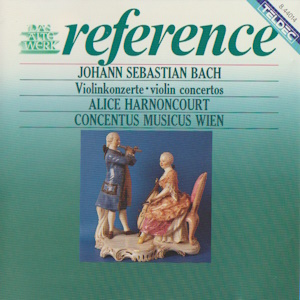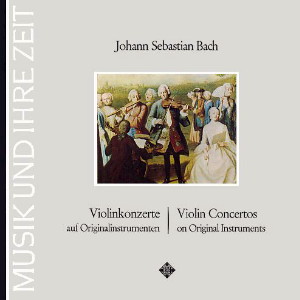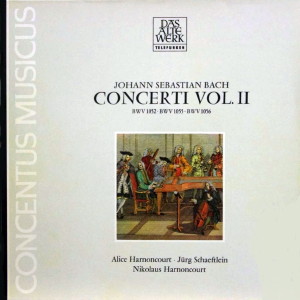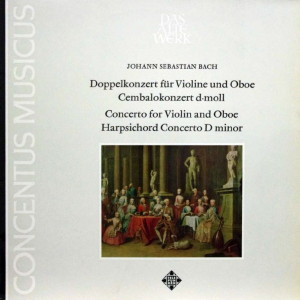 |
| 1 CD -
8.44014 ZS - (c) 1988 |
 |
1 LP -
SAWT 9508-A - (p) 1967 *
|
 |
| 1 LP -
6.42032 AW - (p) 1977 ** |
 |
| 1 LP -
SAWT 9557-B - (p) 1970 *** |
|
VIOLINKONZERTE
|
|
|
|
|
|
|
|
|
|
| Johann Sebastian BACH
(1685-1750) |
Konzert
für zwei Violinen d-moll, BWV
1043 *
|
|
|
|
|
|
- Vivace
|
|
4' 12" |
1 |
A1
|
|
- Largo, ma non
tanto |
|
7' 06" |
2 |
A2
|
|
- Allegro |
|
5' 13" |
3 |
A3
|
|
Konzert
für Violine E-dur, BWV 1042 *
|
|
|
|
|
|
-
Allegro |
|
8' 40" |
4 |
A4
|
|
- Adagio |
|
6' 31" |
5 |
B1
|
|
- Allegro assai |
|
2' 56" |
6 |
B2
|
|
Konzert
für Violine a-moll, BWV 1041 *
|
|
|
|
|
|
- Allegro |
|
4' 10" |
7 |
B3
|
|
-
Andante
|
|
6' 29" |
8 |
B4 |
|
-
Allegro assai |
|
4' 12" |
9 |
B5 |
|
Konzert
für Violine g-moll -
(Rekonstruktion nach dem
Cembalokonzert BWV 1056) ** |
|
|
|
|
|
-
(Allegro) |
|
3' 36" |
10 |
A1 |
|
- Largo |
|
2' 38" |
11 |
A2 |
|
- Presto |
|
3' 34" |
12 |
A3 |
|
Konzert
für Violine und Oboe d-moll,
BWV 1060 *** |
|
|
|
|
|
- Allegro |
|
5' 11" |
13 |
A2 |
|
- Adagio |
|
4' 34" |
14 |
A3 |
|
- Allegro |
|
3' 43" |
15 |
A4 |
|
|
|
|
|
Konzerte BWV 1043, 1043,
1042
|
Konzert BWV 1056 |
Konzert BWV 1060 |
|
|
|
| CONCENTUS
MUSICUS WIEN |
CONCENTUS
MUSICUS WIEN |
CONCENTUS
MUSICUS WIEN |
-
Alice Harnoncourt, Solo-Violine
|
-
Alice Harnoncourt, Solo-Violine |
-
Alice Harnoncourt, Solo-Violine |
-
Walter Pfeiffer, Violine,
Solo-Violine (1043)
|
-
Walter Pfeiffer, Violine |
-
Jürg Schaeftlein, Oboe |
-
Peter Schoberwalter, Violine
|
-
Peter Schoberwalter, Violine |
-
Peter Schoberwalter, Violine |
| -
Stefan Plott, Violine |
-
Wilhelm Mergl, Violine |
-
Wilhelm Mergl, Violine |
| -
Josef de Sordi, Violine |
-
Anita Mitterer, Violine
|
-
Walter Pfeiffer, Violine |
| -
Kurt Theiner, Viola |
-
Veronika Schmidt, Violine
|
-
Josef de Sordi, Violine |
| -
Nikolaus Harnoncourt, Violoncello |
-
Josef de Sordi, Viola
|
-
Stefan Plott, Violine |
-
Eduard Hruza, Violone
|
-
Kurt Theiner, Viola
|
-
Kurt Theiner, Violine |
| -
Herbert Tachezi, Cembalo |
-
Nikolaus Harnoncourt, Violoncello
|
-
Nikolaus Harnoncourt, Violoncello
|
| Nikolaus
HARNONCOURT, Leitung |
-
Eduard Hruza, Violone
|
-
Eduard Hruza, Violone
|
|
-
Herbert Tachezi, Cembalo |
-
Herbert Tachezi, Cembalo |
|
Nikolaus
HARNONCOURT, Leitung |
Nikolaus
HARNONCOURT, Leitung |
|
|
|
|
Luogo
e data di registrazione |
|
Wien
(Austria) - Januar 1967 *
1976 **
Wien (Austria) - März und
September 1969 ***
|
|
|
Registrazione:
live / studio |
|
studio |
|
|
Producer |
|
Wolf
Erichson
|
|
|
Prima Edizione
LP |
|
Telefunken
- SAWT 9508-A - (1 LP) - durata
47' 09" - (p) 1967 - Analogico *
Telefunken - 6.42032 AW - (1 LP) -
durata 45' 21" - (p) 1977 -
Analogico **
Telefunken - SAWT 9557-B - (1 LP)
- durata 42' 11" - (p) 1970 -
Analogico ***
|
|
|
Edizione
"Reference" CD
|
|
Tedec
- 8.44014 ZS - (1 CD) - LC 3706 -
durata 72' 58" - (c) 1988 - AAD |
|
|
Cover |
|
"Das
Gehör", aus einer Folge der "Fünf
Sinne", Porzellan. Modell J. F.
Lück, Frankenthal um 1759. Museum
für Kunst und Gewerbe, Hamburg.
|
|
|
Note |
|
This
Compact Disc is the miscellany of
three Telefunken publications: one
unabridged (SAWT 9508-A) and two
partials: 6.42032 AW (BWV 1056)
and SAWT 9557-B (BWV 1060).
|
|
|
|
|
In the Concerto
in D minor for two
solo violins, the
dialogue does not take
place, as one might
expect, between the solo
instruments, but between
both instruments
and the orchestra. To
make the music “speak”
was one of the chief
desires of composers and
performers. The
articulation of the
semiquaver notes, as in
the first movement of
this concerto, must thus
always be varied, far
removed from the uniform
“Bach stroke”. - In the
slow movement the
orchestra has only a
continuo function. The
two solo instruments vie
with one another in
their wonderful melody,
while here again the
great line may not
inhibit the details of
the phrasing. The
present-day ideal of
continuo sostenuto
playing was foreign to
the musicians of that
time; each note had to
“have its proper
strength and weakness”.
Bach’s phrasing is
meticulous in the
extreme, and never to be
understood as mere
bowing marks but as
specifically required
articulation. - The old
requirement “in each bar
a different emotion” is
very clearly realized in
the third movement. In
the middle of the hectic
chase of the opening
tutti there are two
imploring interjections
by the soloists which
are brusquely rejected
by the orchestra. The
main motif of the solo
violins is formed from
these interjections. The
orchestra adheres to the
impetuous opening motif
throughout the movement.
Specifically prescribed
springing types of
bowing give rise to
jazz-like shifts of
accent. Extreme
contrasts are the main
feature of this
movement.
The Concerto in E
major is, in the
relative weight of its
movements, almost
reminiscent of an
ouverture-suite. In the
broadly conceived first
movement the orchestra
carries the main part of
the musical substance,
whereas the solo is
always of a dreamily
improvisatory character.
The Adagio cadenza of
this movement is
composed without a bass;
the chords otherwise
played here are from the
harpsichord version of
the concerto. There
they make sense, since
such a melody in a
single part sounds
senseless on the
harpsichord, a chordal
instrument; on the
violin the empty,
completely free descent
particuarly underlines
the spontaneous,
improvisatory character
of this part. - The slow
movement is constructed
on an ostinato bass.
Here the soloist has the
opportunity, as already
in the first movement,
for baroque rubato
playing. In the
accompanying string
parts Bach uses the
popular effect of the
bow tremolo or bow
vibrato; the orchestra
accompanies the soloist
in chords “with a
pulsating hand in which
the bow is held, in the
manner of the Tremulant
on the organs...”
(Farina, 17th century).
These weighty movements
are followed by a light
Rondo, in the episodes
of which the solo part
leads ever new
transformations of
arpeggio figures to a
turbulent conclusion. In
the two outer movements
of the Concerto in A
minor, the
thematic material of the
introduction is given
exclusively to the
orchestra,while the solo
passages are strongly
contrasted to it in
expression. In the
accompaniment of some
solo passages of the
first movement, Bach
again uses the bow
vibrato described above.
- In the slow movement,
the basso ostinato is
not played exactly in
rhythm as noted down
but, in accordance with
the rules of the time,
the demisemiquaver group
is played somewhat late.
The Finale acquires a
dance-like character
through the rhythm and
forward-driving energy
of the gigue.
The music world has long
since been aware of the
fact that, in addition
to the famous violin
concertos in A minor and
E major, as well as the
double concerto in D
minor. Johann Sebastian
Bach composed further
violin concertos and at
least one oboe concerto.
Some of the missing
concertos were preserved
in the form of
harpsichord concertos as
arranged by Bach
himself. For this reason
not only enthusiastic
Bach virtuosos, but
lately also Bach
researchers (Siegel
1957, Fischer 1971 and
Breig 1976) have gone
into the question of
whether and to what
extent it is possible
approximately to recover
the lost originals by
means of reconstruction.
Musicological
investigations
concentrated in
particular on the
autograph (written by
Bach himself) scores of
the harpsichord
versions, since these
reflect the process of
rearrangement in many
details (violin effects
in the harpsichord
descant, corrective
processes, insertions,
melody turns, basic
changes or octave
transpositions taking
into account the
restricted tonal range
of the harpsichord,
unusual part leading,
among other things).
Evaluations of such
characteristics was
considerably eased by
the fact that also the
violin concertos in A
minor and E major and
the 4th Brandeburg
concerto (actually also
a violin concerto) have
come down to us as
autograph arrangements
for harpsichord
providing important
clues to Bach’s working
techniques. The method
of critical examination
of the sources is also
the basis of
reconstructions of the Violin
Concertos in D minor
(according to the
Harpsichord Concerto in
D minor, BWV 1052) and
in G minor
(according to the
Harpsichord Concerto in
F minor, BWV 1056).
As with the D minor
concerto, the keyboard
(harpsichord) concerto
in F minor leaves no
doubts about its
original existence as a
violin concerto,
and what is more, in
G minor. The fact
that only the violin can
be regarded as the
original solo instrument
is evident from typical
violin passages in the
harpsichord descant,
which to start with was
designed with the open G
string in mind, as well
as from other
violinistic performance
figures which cannot be
reproduced on the
harpsichord with the
same effect. That G
minor instead of F minor
was the original key of
the concerto is
apparent, among other
things, from unusual
voice leading, which can
only be explained by
transposition from G
minor to F minor. Bach
evidently saw himself
compelled to transpose
the keyboard version due
to the fact that the
original violin part
(tonal range g to
e-flat’”) exceeded the
tonal range of the
harpsichord (highest
note normally d’”). The
three movements of the
work, which greatly
differ with regard to
manner and content,
could be interpreted as
the musical
representation of
different temperaments.
The first movement in the
main draws its effect
from the contrast
between the sedate
ritornello theme (with
its insistent repetition
of rhythmic and melodic
flourishes) and the
lively triplet motion of
the solo part. The Largo
on the other hand with
its wideranging melodic
arcs is more inclined to
display romantic traits.
As opposed to this, the
concluding movement
marked “Presto” is
markedly illhumoured in
temperament, expressing
itselfin the spirited
ritornello theme, in an
almost complementary
rhythmic semiquaver
movement, in the playful
imitation of pithy
motifs, in sweeping
alternating figures and
dramatic question and
answer passages. There
is every indication that
Bach did not insert the
centre movement until
arranging the
harpsichord version; the
original centre movement
has therefore been lost.
Thus, in the interest of
musical practice the New
Bach Edition has taken
over the Largo of the
keyboard version
transposed to B-flat
major and transcribed
for violin in the
reconstruction form.
The Double Concerto
for Violin and Oboe
has come down to us only
in a C minor arrangement
for two harpsichords.
The difference between
the two solo parts and
the frequent unison
passages of the first
solo part with the tutti
violins lead to the
probably correct
assumption that here we
have the missing
Concerto for Violin and
Oboe listed in the
Breitkopf catalogue as
no. 1764. By transposing
the work back to D minor
the arpeggio passages on
the violin (open A’ and
E” strings) acquire a
natural technical
facility. For this
recording we have tried
to achieve a new
reconstruction, using as
models Bach’s own
arrangements of other
concertos, in particular
of violin concertos
where both versions are
extant. Without any need
for additional
“arranging”, merely from
the techniques of the
instruments, the
solutions presented
themselves so naturally
that we believe we have
come very near to the
lost original.
|
|